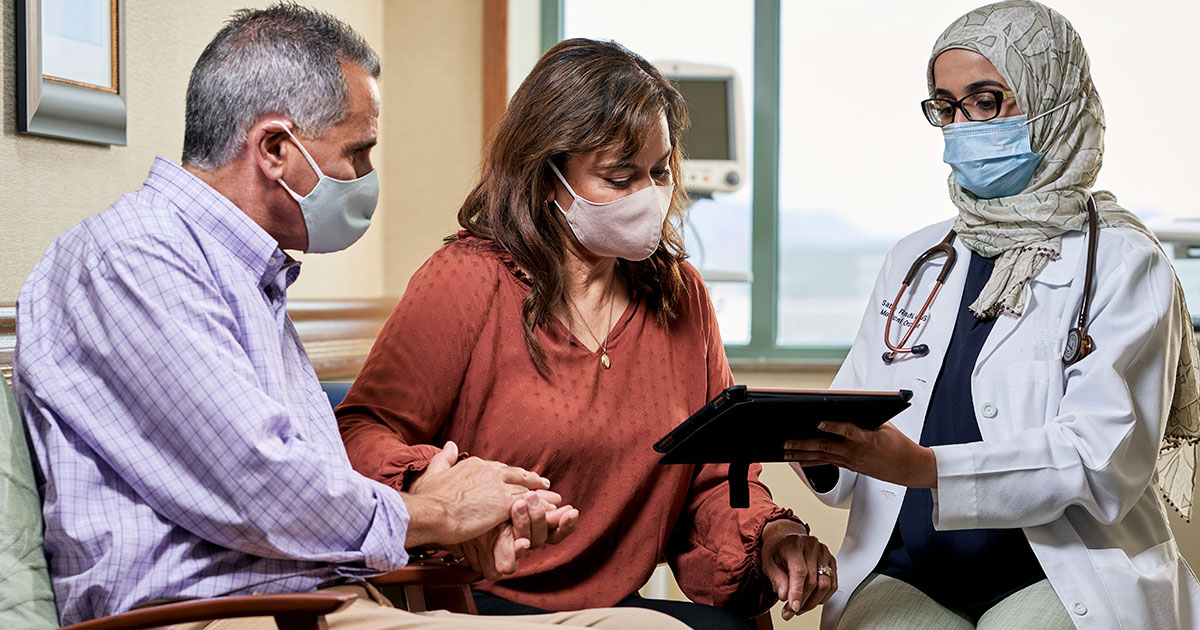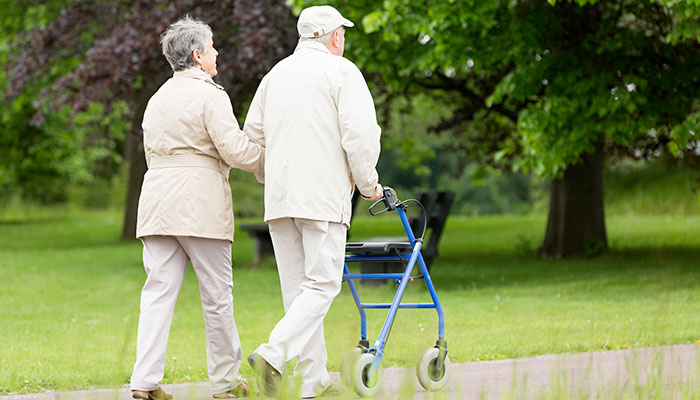
Amid the many questions about cancer that scientists keep exploring, one answer about what causes the disease hasn’t changed throughout decades of research: The most significant risk factor for developing cancer is getting older.
For example, cancer is diagnosed in fewer than 25 per 100,000 Americans under age 20, making up just 1 percent of all cancer diagnoses, according to the National Cancer Institute (NCI). That rate grows to 350 cases per 100,000 for Americans between the ages of 45-49. And for adults aged 60 and older, that rate nearly triples to 1,000 cases of cancer per 100,000 people.
Scientists understand a bit about why cancer risk increases with age, but they have much more to learn, especially considering how much the risk varies from one cancer to another.
In this article, we’ll explore:
- Cancer risk by age
- Age and cancer risk: What’s the connection?
- Chart: Odds of getting cancer by age and cancer type
- Why are cancer rates increasing in young adults?
- Lowering your cancer risk at any age
If you’ve been diagnosed with cancer and are interested in a second opinion on your diagnosis and treatment plan, call us or chat online with a member of our team.
Cancer risk by age
No one is immune from the risk of cancer, young or old, but age does play a role in who’s most likely to get cancer. The average age of individuals diagnosed with cancer is 66, according to the NCI. That means about half of all cancer cases are diagnosed in people 66 and older, and the risk continues to increase with age.
Though the trend of increasing diagnoses with advancing age is true for cancer overall, the incidence of individual cancers may vary substantially. In fact, a handful of cancers are diagnosed more often in younger people.
For instance, according to the NCI and the American Society of Clinical Oncology (ASCO):
About one in four cases of bone cancer is diagnosed in children and teens. The average age of a patient diagnosed with bone cancer is 46.
More than half of all cases of acute lymphocytic leukemia (ALL) are diagnosed in those under age 20. The average age of an ALL patient at diagnosis is 17.
Half of all cases of testicular cancer are diagnosed in men 20 to 34 years old. The average age of a patient diagnosed with cancer of the testes is 32.
More than 40 percent of patients with Hodgkin lymphoma are age 34 or younger. The average age of a patient at diagnosis is 39.
But these cancers are relatively rare, according to the American Cancer Society, (ACS), and are exceptions to the general rule about cancer risk increasing with age. By and large, the biggest contributing risk factor for most cancers is older age, as these numbers demonstrate:
- 1 percent of cancer cases are diagnosed in people under age 20.
- 2.7 percent of cases are diagnosed in between ages 20-34.
- 4.8 percent of cases are diagnosed in between ages 35-44.
- 11.3 percent of cases are diagnosed in between ages 45-54.
- 24.1 percent of cases are diagnosed in between ages 55-64.
- 29.7 percent of cases are diagnosed in between ages 65-74.
- 18.7 percent of cases are diagnosed in between ages 75-84.
- 7.7 percent of cases are diagnosed in in those older than 84.
Add up the percentages, and 80.2 percent of cases are diagnosed in patients older than 55, and 3.7 percent of all cases are detected in patients younger than 34.

Age and cancer risk: What’s the connection?
Some reasons for the link between cancer and older age are straightforward, such as the simple fact that human immune systems become weaker with age and therefore are less efficient at killing cancerous cells before they multiply. The immune system’s effectiveness starts gradually declining around age 20, but that decline accelerates substantially in the 60s. As the immune system’s response slows down, so does its ability to find and correct defects in cells.
Another factor is the gradual deterioration of cells and their proteins. The human body is like a copy machine with no off switch that spends its entire life producing copies of new cells to replace those that have died. Like a copier that produces paper copies of copies year after year, over time, those copies may become distorted and look very different than the original or early versions. As the human body produces new copies of cells over the years, the chances for mutations or defective cells increase.
Getting older also comes with several "hallmarks of aging” that overlap with key contributors to cancer. These include:
- Genomic instability, or the gradual accumulation of genetic damage during a person’s lifetime
- Everyday exposures to risk factors, such as ultraviolet rays from the sun, which increases the likelihood of skin cell damage that may lead to skin cancer and melanoma
- Continued smoking over many years
- Viral infections
- Exposure to chemical pollutants or air pollution
- Occupational hazards
Other aspects of the link between aging and cancer are still under investigation, such as the role of epigenetics, or how environmental exposures change the makeup of our DNA. It’s possible, for example, that dietary changes could speed up or slow down some of these changes, but scientists are just beginning to understand the ways that might be possible.
Chart: Odds of getting cancer by age and cancer type
Here are the estimated new cases and deaths in 2023 and the average ages at diagnosis for the 10 most common cancers in the United States:
| Cancer type | |||
|---|---|---|---|
| Breast cancer (Female) | |||
| Prostate cancer | |||
| Lung cancer | |||
| Colorectal cancer | |||
| Melanoma of the skin | |||
| Bladder cancer | |||
| Kidney cancer | |||
| Non-Hodgkin lymphoma | |||
| Uterine cancer | |||
| Pancreatic cancer |
Why are cancer rates increasing in young adults?
While most cancers are more common among senior citizens, researchers have documented dramatic increases in cancer in adults younger than 50.
For instance, overall cases of colorectal cases have been declining since 1985, from 65 per 100,000 Americans to 34. Meanwhile, the percentage of new cases in Americans younger than 55 has nearly doubled since 1995, from 11 percent to 20 percent. Colorectal cancer is now the leading cause of cancer deaths for Americans 20 to 49 years old, according to the NCI.
Another example: The average age of a woman diagnosed with uterine cancer is 63. But in a presentation delivered to ASCO, researchers noted that cases of uterine cancer doubled from 2001 to 2017, from 0.6 per 100,000 to 1.2 in women aged 20 to 29 and from 4.6 to 7.5 per 100,000 in women aged 30 to 39.
Other cancers rising in young adults include:
Some of the causes behind the increased cancer rates for adults under age 50 are thought to include:
- Drinking alcohol to excess
- Using tobacco products
- Being obese or overweight
- Getting too little sleep
- Using oral contraceptive
- Being exposed to environmental toxins
The trend has prompted some health agencies to recommend screenings for some cancers at younger ages. The ACS now recommends that colorectal cancer screening for adults at average or low risk should begin at the age of 45, instead of 50, the previous recommendation. And the U.S. Preventative Services Task Force recently released a draft recommendation that women begin breast cancer screening at age 40 instead of 50.
Lowering your cancer risk at any age
Just because getting older increases the likelihood of cancer doesn’t mean you can’t take steps to offset that risk. Developing healthy lifestyle habits and following screening guidelines can go a long way toward reducing cancer risk at any age.
Some healthy behaviors that reduce cancer risk are well known, such as not smoking or quitting smoking if you’ve already started. But fewer people probably know that cutting back on alcohol and consistently getting enough sleep may also reduce their risk of cancer.
Other healthy habits that lower risk include:
- Getting regular exercise or being physically active
- Reducing the time you spend sitting
- Maintaining a healthy weight
- Eating a diet rich in fruits and vegetables and less red meat, fried foods, sugar and processed food
Incorporating these healthy habits into daily life cannot guarantee you won’t get cancer, but each can help reduce your overall risk.
If you’ve been diagnosed with cancer and are interested in a second opinion on your diagnosis and treatment plan, call us or chat online with a member of our team.



